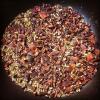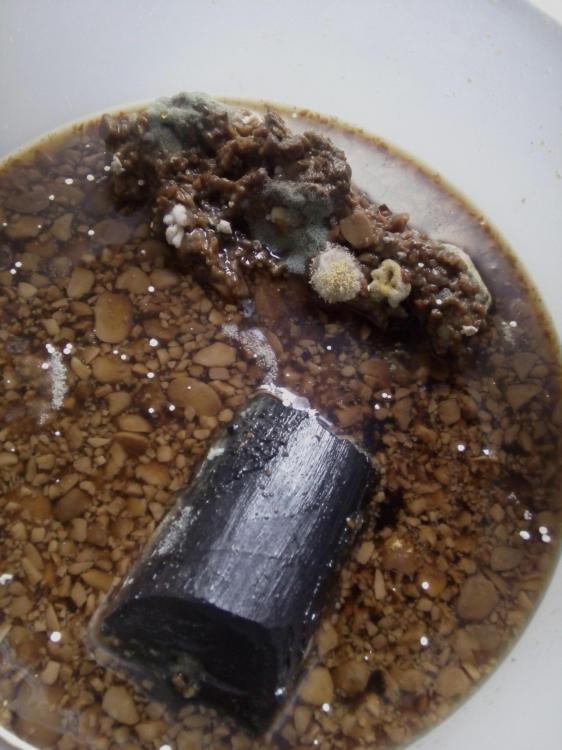-
Posts
18 -
Joined
-
Last visited
Content Type
Profiles
Forums
Store
Help Articles
Everything posted by danielkurniadi
-
After 4 months and going very well, somebody put my container below birdcage. The result is: something from that bird felldown into my container, bird food or maybe its feces. And grow another mold on my soycake. So consider it spoiled. RIP my Soy Sauce. Maybe i must stop this. Before i kill somebody LOL.. AAARRRGGHH!!!
-
Divide meju to 4 pieces, then here is how it looks, get some mold inside too. Finally, fermenting time! got a 2 litres plastic container. Today is 9 October 2015 (as my reminder) This brine contain 20% kosher salt. (without iodine).
-
After calculating from http://www.wikihow.com/Make-Soy-Sauce, 370gr of meju only use 800gr of water. dang.. i must find smaller container. then i found clay pot for boil Chinese herbal medicine, can hold 1 litre ++. still sterilizing with boiling some water directly on stove. PS: forget about the clay pot. it got crack, water drip out.. how unlucky
-
OK, i decide to dip my meju / soy cake after... errrr.. (i forgot the first date i fermented my soy cake.. wait.. I'll count it from my last post ) owww its 5 september 2015 and today is 5 October, exactly a month then.. its completely dried with not so much mold, you can see in the photo. has a little "meaty" and soy smell, plus little bit of bamboo smell. i just leave it in direct sunlight day and night and about 2 weeks i just leave it in warm warehouse / closet upstairs (actually almost forget about it hehe). and what i found in the room, an old 30 years glass jar, i remembered this jar on my dining table back in 80's, i've measured it and it contains 3,7 liters of water, so its 1 US gallon volume. marked it. my tap water and well water are about 250 ppm, so its rather hard water, and must be boiled first (well, its Indonesia lol), or can i use reversed osmosis water as well? and how much water needed to ferment 370 grams of dried meju? thanks. will dip the meju right wafter i got water level suggestion.
-
So, Takadi, i must weight my soycake, my water, and then weight 18% salt (from total weight cake + water) and put into the water? Hummingbirdkiss: No, its not desease, maybe it just came from our DNA. Lol
-
Hello hummingbirdkiss, welcome to the DIY club
-
Hai Takadi, can you tell me why we need to weight the actual soybean and flour?
-
more update: i dry the meju in direct sunlight at noon, and move it to dark and warm room at night, the result is good, when i move them in the morning, heat generated under the basket, feel warm. black, white, and pinkish / orange mold. no maggots .
-
Hello again, this is 3rd batch experiments. changed the cover with a better one. i just exposed the meju directly to the sun and moon for 3 days and i realized it still wet inside but dry outside, and mold starting to grow. same white and black mold. but i hope this time without maggots OK, will report more in few days.
-
Experiment number three: Meju Making. 500gr of dry soy beans. Steamed for 2,5 hours! Mashed and put into a bowl, then pressed with hands. make air pocket as little as possible Cheese anyone? OK, tomorrow must find a good plan to avoid flies. Problem solved! See you tomorrow!
-
Thanks for the link Takadi. My mom just told me about her childhood experience, my great grandmother made her own taucho (indonesian taushi?) Using ungrounded soy bean, steamed, combine with rice flour (not wheat, wheat doesn't grow in indonesia), add tempe yeast, and fermented in a ceramic jar. And she said that the mold should be white and yellowish. And now i persuade her to make an experiment on her own hahaha. She bought tempe, slice it thinly, put in an airy place, then when moldy she dried it under direct sunlight on a baking tray. I'll post the photo later
-
Shelby: yes i am! still soaking 1/2 Kg of soya bean again Takadi: i think so, the weather now is quite hot and humid here in Indonesia. and i think maggots comes from fly eggs which laid down on the soy cake, maybe next time i'll put some "barrier" to prevent flies coming. I have an idea using Korean method, which mean make "Meju". From pure soya bean, no other rice or grain like Chinese or Japanese method. I watched on Youtube, here: looks easier hehehe.. Thanks for your reply.
-
UPDATE: Rest in peace soycake number 2. The wold is successful but i found a lot of maggots. Discard right away! *sigh* I suspect small flies around the bamboo tray.
-
Hello Takadi, nice to meet you. My question to you: is the black mold really safe? Not poisonous? My soycake contain white and black mold only. I'll take a picture soon Soycakes day 5: Even mold grows on the back of bamboo tray Are those soy cakes ready to put in brine? or need more days? Thanks, Takadi.
-
Second batch, 3rd day. the black mold still dominant, and white mold only seen on the top of the soy cake. i sprayed directly with water sprayer to keep them moist. top it with some newspaper to make dark environment. PS: the black mold maybe Mucor racemosus Fresenius, which involved in Tou Shi fermentation in Sechuan.
-
After 5 days, my soy cake turns dry and hard, and the fungus looks terrible, more black fungus than the white one. am i failed? or the fungus dead? suggestion please?
-
My soy cake on 3rd day. i think Indonesia has the right climate / humidity for growing mold white powder is all purposed wheat flour, to prevent soycake stick on the bamboo. Got error in first trial, it supposed to steam / cook first then blend, but i accidentaly blend first, then after half way, i realized that i haven't cook it yet. LOL. i boiled it, and have an extra pot of soy milk well, i'll soak some soy again tonight, making new one, with the right method.
-
Hello and greetings from Indonesia, Thank Goodness i found this forum. I'm interested in making my own soy sauce, just buy some soy beans and still soak them for overnight before cook'em. As tropical country, sun and humidity is ideal to make soy sauce. Here we have our unique soy sauce called "Kecap" (just like ketchup pronounciation). There are two varieties, Sweet (Kecap Manis) and Salty (Kecap asin), basicly use black soy bean, palm sugar, garlic, cinnamon, star anniseed, etc. But unfortunately i don't have any relative who related with traditional kecap factory. i let you know when i get some information. A lot of traditional kecap factory closed because of no more market, no next generation owner (commonly they are family business), losing market to modern huge factory, or lack of ingredient supplies. I wish i can taste my own soy sauce later, and preserving cultural heritage? I will update my progress. Wish me luck. Thanks. Daniel Kurniadi Smokie Nduty Artisan Charcuterie www.facebook.com/SmokieNduty




